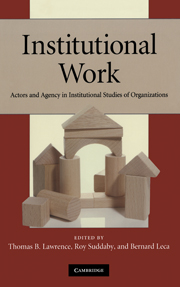Book contents
- Frontmatter
- Contents
- List of figures
- List of tables
- List of contributors
- 1 Introduction: theorizing and studying institutional work
- Part I Essays on institutional work
- Part II Studies of institutional work
- 6 Building the iron cage: institutional creation work in the context of competing proto-institutions
- 7 Scandinavian institutionalism – a case of institutional work
- 8 Institutional maintenance as narrative acts
- 9 Maintaining an institution in a contested organizational field: the work of the AACSB and its constituents
- 10 Institutional “dirty” work: preserving institutions through strategic decoupling
- 11 Doing which work? A practice approach to institutional pluralism
- Index
- References
11 - Doing which work? A practice approach to institutional pluralism
Published online by Cambridge University Press: 15 September 2009
- Frontmatter
- Contents
- List of figures
- List of tables
- List of contributors
- 1 Introduction: theorizing and studying institutional work
- Part I Essays on institutional work
- Part II Studies of institutional work
- 6 Building the iron cage: institutional creation work in the context of competing proto-institutions
- 7 Scandinavian institutionalism – a case of institutional work
- 8 Institutional maintenance as narrative acts
- 9 Maintaining an institution in a contested organizational field: the work of the AACSB and its constituents
- 10 Institutional “dirty” work: preserving institutions through strategic decoupling
- 11 Doing which work? A practice approach to institutional pluralism
- Index
- References
Summary
This chapter takes a social theory of practice approach to examining institutional work; that is, how institutions are created, maintained, and disrupted through the actions, interactions, and negotiations of multiple actors. We examine alternative approaches that organizations use to deal with institutional pluralism based on a longitudinal real-time case study of a utility company grappling with opposing market and regulatory logics over time. These two logics required the firm to both mitigate its significant market power and also maintain its commercially competitive focus and responsiveness to shareholders.
Institutional theorists have long acknowledged that institutions have a central logic (Friedland & Alford, 1991) or rationality (DiMaggio & Powell, 1983; Scott, 1995/2001; Townley, 2002), comprising a set of material and symbolic practices and organizing principles that provide logics of action for organizations and individuals, who then reproduce the institutions through their actions (Glynn & Lounsbury, 2005; Suddaby & Greenwood, 2005). Despite a monolithic feel to much institutional theory, in which a dominant institutional logic appears to prevail, institutional theorists also acknowledge the plurality of institutions (e.g. Friedland & Alford, 1991; Kraatz & Block, 2008; Lounsbury, 2007; Meyer & Rowan, 1977; Whittington, 1992). While these pluralistic institutions may be interdependent, they are not considered to coexist in harmony; “There is no question but that many competing and inconsistent logics exist in modern society” (Scott, 1995: 130).
- Type
- Chapter
- Information
- Institutional WorkActors and Agency in Institutional Studies of Organizations, pp. 284 - 316Publisher: Cambridge University PressPrint publication year: 2009
References
- 99
- Cited by



